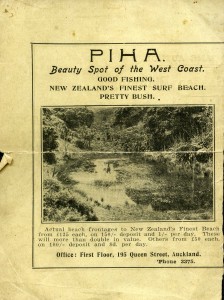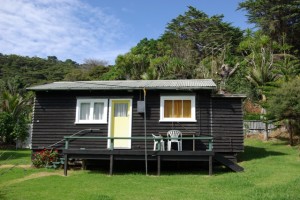After the closure of the Mill in 1921, Piha went through a period of quiet. But in 1926, Richard Kibblewhite, an Auckland architect, attempted to subdivide Piha. Plans were drawn up and Kibblewhite used to advertise hisWest Coast Estate properties by having his toddler daughter, Betty, make sandcastles in a shop window in Queen Street. Kibblewhite moved into the old Railway Clerk’s House and waited for clients.
He did sell properties in Garden Road and Beach Valley Road, but not enough. Economic times were bad and the fact that there was no road into Piha, deterred all but the very keen.
Kibblewhite went bankrupt, but his family never lost their love of the Coast and it became their holiday place – not a bad consolation prize.
On the death of Dr Rayner, his estate once again marketed Piha. By this time, Relief Workers in the Depression had cut a road down to Piha, and as the economy picked up, the sections sold. Rayner’s estate, with real estate representative, Mr Jarrett, set up an office in the Domain and they offered fantastically favourable terms. Affordable weekly payments with no interest for five years, then pay the lot off or convert to a loan with interest.
Most of the purchasers were young people attracted by the opportunities to surf and enjoy the outdoors. On the prime beachfront sections, professionals and businessmen picked up the best spots.
There were successive subdivisions, with Garden Road, Beach Valley Road, and Piha beachfront first. Rayner Road, Seaview Rd and North Piha followed, though the subdivision of North Piha, north of Kingston’s Corner, did not occur till owner Les Waygood subdivided at mid-century.
Gradually necessary but minimal services followed, with Mrs Ketterer’s beachfront and Beach Valley Road stores first, though these were mainly for day trippers, brought out by bus. Milk was available from the boarding house milking shed, and other supplies came out on the bus or were brought in heavily laden bach-owners’ cars.
The core of Piha, especially the beach front, still carries on the bach tradition, though the small humble baches of yesteryear are in some cases being extended and modernised.




